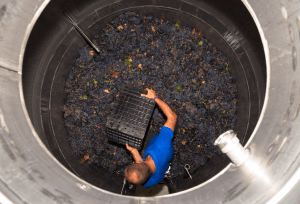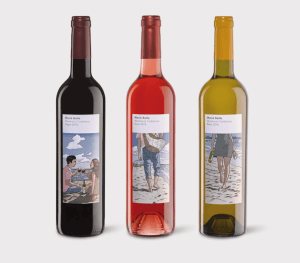We assume that wine was discovered when the primitive man took a bunch of grapes, left them in a bowl and, after a few days, the grapes started juicing and that juice started to ferment spontaneously. We imagine that this is how wine was discovered. This process is carbonic maceration.
In other words, what we really do is reproduce the oldest form of wine making.
The name Carbonic Maceration, (introduced by the French chemist Louis Pasteur) is synonymous with young, fresh and explosively fruity wines that are much more than merely a new wine.
The process followed during the classic carbonic maceration is the following: Harvest is carried out by hand, bringing the entire bunches into the winery, without destemming. These bunches of grapes are placed in the fermentation tanks without stripping, pressing or squeezing, so that the grapes enter the tank intact. Once the tank is filled up to its capacity, it is closed and the phenomenon begins.

Maceración Carbónica
The bunches of grapes at the bottom are crushed by the weight of the grapes themselves, so that in the must producing at the bottom of the tank, alcoholic fermentation starts spontaneously. As many grapes aren’t submerged in the must, inside each grape, intracellular enzymatic fermentation takes place. Once fermentation starts, two workers enter the tank to perform the traditional grape-stomping.
The workers stomp the grapes with their feet to crush the grapes in fermentation and thus achieve a pressing by stomping to extract a more concentrated must and avoid the extraction of stalk tannins.

Macià Batle Maceración Carbónica 2016
The 2017 vintage
The yield of the 2017 vintage has been inferior to previous vintages and of very good quality. The great work carried out on the vineyards during the entire year has allowed us a harvest of healthy, mature grapes with a high graduation of acidity, promising long-lived wines with freshness and elegance..
The wine
New red wine elaborated through the traditional carbonic maceration with the indigenous variety manto negro, originating in its majority exclusively from our vineyards.
The pre-fermentation maceration of the cold grapes, short fermentation in the stainless steel tank combined and the traditional stomping of the grapes bestow this wine with a marked personality, making it different from all other wines of its kind.
Tasting notes
The fruity aroma of blackcurrant and blackberry is emphasized, the passage is pleasant and lasting, with nuances of liquorish and fruit gums standing out. The absence of astringency makes it pleasant to the palate and is the most relevant characteristic of the wines of carbonic maceration, a method recovered by our wineries for the wines from Mallorca.
Pairing
It is an intense wine, ideal for pasta, pizza, cold meats, traditional dishes and especially the best wine for family lunches and barbecues. It is recommend to serve the wine slightly cooled.

Maceración Carbónica 2016



